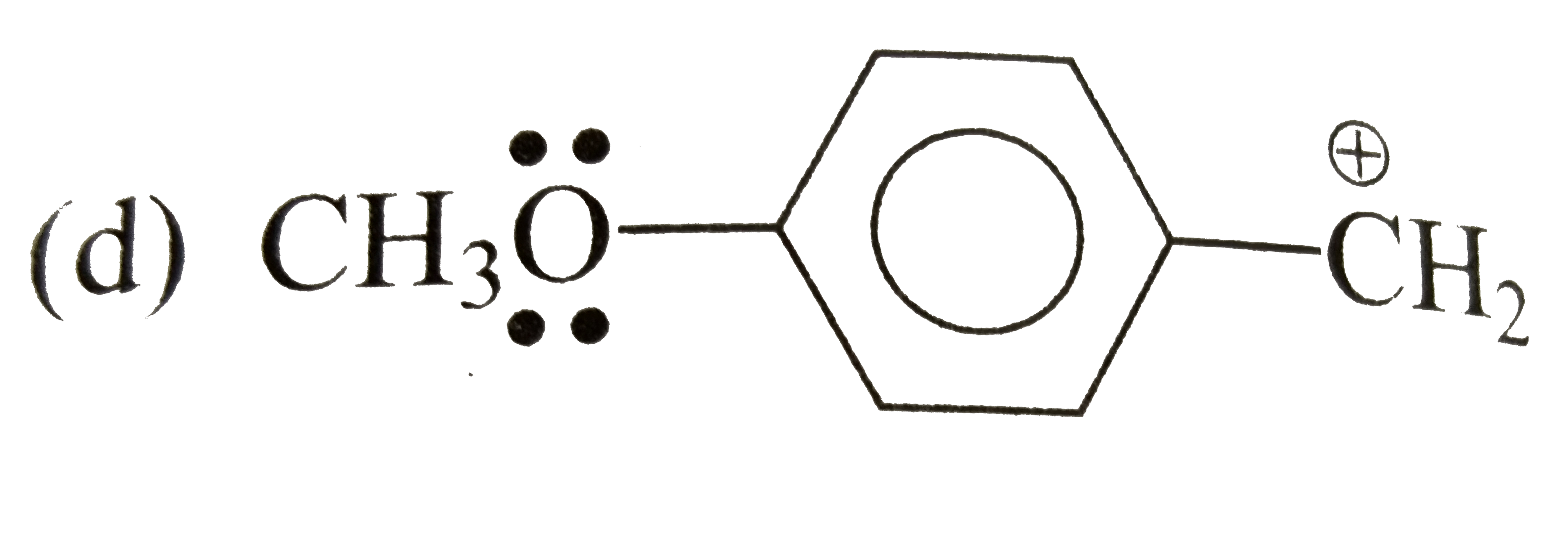Most stable carbanion is :-
HC≡¯¯¯C
H2C=¯¯¯¯¯¯CH
CH3−CH3∣C∣CH3−¯¯¯CH2
CH3−C∣CH3H−¯¯¯CH2
The correct Answer is:A
To determine which carbanion is the most stable, we need to analyze the hybridization and the s-character of the carbanions provided. Here’s a step-by-step solution:
Step 1: Identify the Carbanions
We are given four carbanions. Let's denote them as:
- Carbanion A: 1 sigma bond, 1 lone pair
- Carbanion B: 2 sigma bonds, 1 lone pair
- Carbanion C: 3 sigma bonds, 1 lone pair
- Carbanion D: 3 sigma bonds, 1 lone pair
Step 2: Determine Hybridization
- Carbanion A:
- 1 sigma bond + 1 lone pair = Steric number 2
- Hybridization: sp
- Carbanion B:
- 2 sigma bonds + 1 lone pair = Steric number 3
- Hybridization: sp²
- Carbanion C:
- 3 sigma bonds + 1 lone pair = Steric number 4
- Hybridization: sp³
- Carbanion D:
- 3 sigma bonds + 1 lone pair = Steric number 4
- Hybridization: sp³
Step 3: Calculate s-character
- Carbanion A (sp):
- s-character = 50% (1 s orbital out of 2 total orbitals)
- Carbanion B (sp²):
- s-character = 33.3% (1 s orbital out of 3 total orbitals)
- Carbanion C (sp³):
- s-character = 25% (1 s orbital out of 4 total orbitals)
- Carbanion D (sp³):
- s-character = 25% (1 s orbital out of 4 total orbitals)
Step 4: Analyze Stability
The stability of carbanions is influenced by the s-character of the hybrid orbitals:
- Higher s-character means greater electronegativity and better ability to stabilize the negative charge.
- Carbanion A has the highest s-character (50%), followed by Carbanion B (33.3%), and both Carbanion C and D have the lowest s-character (25%).
Conclusion
Since Carbanion A has the highest s-character, it is the most stable carbanion among the options provided.
Final Answer: Carbanion A is the most stable carbanion.
We are given four carbanions. Let's denote them as:
- Carbanion A: 1 sigma bond, 1 lone pair
- Carbanion B: 2 sigma bonds, 1 lone pair
- Carbanion C: 3 sigma bonds, 1 lone pair
- Carbanion D: 3 sigma bonds, 1 lone pair
- Carbanion A:
- 1 sigma bond + 1 lone pair = Steric number 2
- Hybridization: sp
- Carbanion B:
- 2 sigma bonds + 1 lone pair = Steric number 3
- Hybridization: sp²
- Carbanion C:
- 3 sigma bonds + 1 lone pair = Steric number 4
- Hybridization: sp³
- Carbanion D:
- 3 sigma bonds + 1 lone pair = Steric number 4
- Hybridization: sp³
- Carbanion A (sp):
- s-character = 50% (1 s orbital out of 2 total orbitals)
- Carbanion B (sp²):
- s-character = 33.3% (1 s orbital out of 3 total orbitals)
- Carbanion C (sp³):
- s-character = 25% (1 s orbital out of 4 total orbitals)
- Carbanion D (sp³):
- s-character = 25% (1 s orbital out of 4 total orbitals)
The stability of carbanions is influenced by the s-character of the hybrid orbitals:
- Higher s-character means greater electronegativity and better ability to stabilize the negative charge.
- Carbanion A has the highest s-character (50%), followed by Carbanion B (33.3%), and both Carbanion C and D have the lowest s-character (25%).
Since Carbanion A has the highest s-character, it is the most stable carbanion among the options provided.
Topper's Solved these Questions
- SOME BASIC PRINCIPLES AND TECHNIQUESBOOK - NARAYNACHAPTER - SOME BASIC PRINCIPLES AND TECHNIQUESEXERCISE - EXERCISE - I (H.W) (TYPES OF REACTION AND MECHANISM)
2 Videos
- SOME BASIC PRINCIPLES AND TECHNIQUESBOOK - NARAYNACHAPTER - SOME BASIC PRINCIPLES AND TECHNIQUESEXERCISE - EXERCISE - I (H.W) (METHODS OF PURIFICATION OF ORGANIC COMPOUNDS)
17 Videos
- SOME BASIC PRINCIPLES AND TECHNIQUESBOOK - NARAYNACHAPTER - SOME BASIC PRINCIPLES AND TECHNIQUESEXERCISE - EXERCISE - I (H.W) (CLEAVAGE OF BONDS AND ELECTRONIC DISPLACEMENTS )
7 Videos
- SOME BASIC CONCEPTS OF CHEMISTRYBOOK - NARAYNACHAPTER - SOME BASIC CONCEPTS OF CHEMISTRYEXERCISE - EXERCISE - IV
43 Videos
- STATES OF MATTERBOOK - NARAYNACHAPTER - STATES OF MATTEREXERCISE - A & R TYPE QUESTIONS
16 Videos
Similar Questions
Knowledge Check
An organic reaction occurs by using reagents called electrophiles and nucleophiles via the formation of some reactive intermediates called carbocations, carbanions, free radicals, carbenes, nitrenes, radical cations, and radical anions.
The most stable carbocation is :APh⊕CH2B C
C D
D
The most stable carbocation is :
A B
B C
C D
D
Most stable carbocation is :
A B
B C
C D
D
